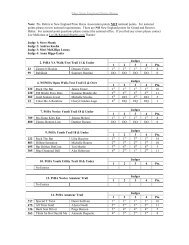2011 Official Rule Book - New England Pinto Horse Association
2011 Official Rule Book - New England Pinto Horse Association
2011 Official Rule Book - New England Pinto Horse Association
You also want an ePaper? Increase the reach of your titles
YUMPU automatically turns print PDFs into web optimized ePapers that Google loves.
owner of the sire, nor do the get shown need to be owned<br />
by one person. Entry must include the name of the sire.<br />
More than one set of entries per sire may be entered in<br />
the same class. Emphasis shall be placed on reproductive<br />
likeness (but not color or pattern likeness), conformation,<br />
and quality. Sires must be registered with the PtHA.<br />
Sires are not to be shown. Note: Breeding stock <strong>Pinto</strong>s<br />
are eligible to participate in group classes (Get of Sire,<br />
Produce of Dam, etc.).<br />
3. Exhibitor’s <strong>Pinto</strong> Group – Group of three <strong>Pinto</strong>s of any age<br />
or sex all owned by the same exhibitor shall be shown.<br />
One handler per horse. Entry is to be made in the name of<br />
all three horses. Emphasis shall be placed on uniformity,<br />
quality, and conformation.<br />
4. <strong>Pinto</strong> Mare and <strong>Pinto</strong> Foal – Mare with foal of the current<br />
year shall be shown. Mare and foal do not have to be<br />
owned by the same person. One handler per horse. Entry<br />
is to be made by the owner of the mare and in the names<br />
of both mare and foal. Emphasis shall be placed upon<br />
quality and conformation. Mare and foal must be PtHA<br />
registered.<br />
K. wEsTERn PERFoRManCE<br />
See also General Show <strong>Rule</strong>s, I1 & I2<br />
K1. General western Classes<br />
A. Entries may be judged for soundness and conformation before<br />
entering the arena.<br />
B. Any <strong>Pinto</strong> showing evidence of altered tail carriage may be<br />
penalized.<br />
C. If bridles are to be removed for bit checks, riders must be<br />
dismounted. It is the responsibility of the judge to check bits.<br />
D. Split Reins<br />
1. One hand is to be used on the reins and the hand must not<br />
be changed.<br />
2. The hand is to be around the reins.<br />
3. Index finger only between split reins is permitted.<br />
4. The tails of the reins must be crossed on the opposite<br />
side of the neck when riding with two hands on split reins,<br />
except in working cow horse and reining.<br />
5. Closed reins, (example mecate) may not be used with a<br />
snaffle bit except in working cow horse and reining, where<br />
a mecate is permitted.<br />
6. In trail, it is permissible to change hands to work an<br />
obstacle.<br />
7. Exception to the rule will be the following classes:<br />
a. Hackamore/snaffle bit classes<br />
b. Junior <strong>Horse</strong>s shown with hackamore/snaffle bit<br />
8. Violation of this rule is an automatic disqualification.<br />
E. Romal Reins<br />
1. Romal is defined as an extension of braided material<br />
attached to closed reins.<br />
2. This extension shall be carried in the free hand with a<br />
minimum of sixteen (16) inch (40 cm) spacing between the<br />
reining hand and the free hand holding the romal.<br />
a. When using romal reins, the rider’s hand shall be<br />
around the reins with the wrists kept straight and<br />
relaxed, the thumb on top and the fingers closed lightly<br />
around the reins.<br />
b. When using a romal, no fingers between the reins are<br />
allowed.<br />
c. The free hand may be used to adjust the rider’s length<br />
of rein in any class listed, including the reining portion<br />
of Working Cow <strong>Horse</strong>.<br />
<strong>2011</strong> PtHA <strong>Rule</strong> <strong>Book</strong> 91<br />
ClassEs



